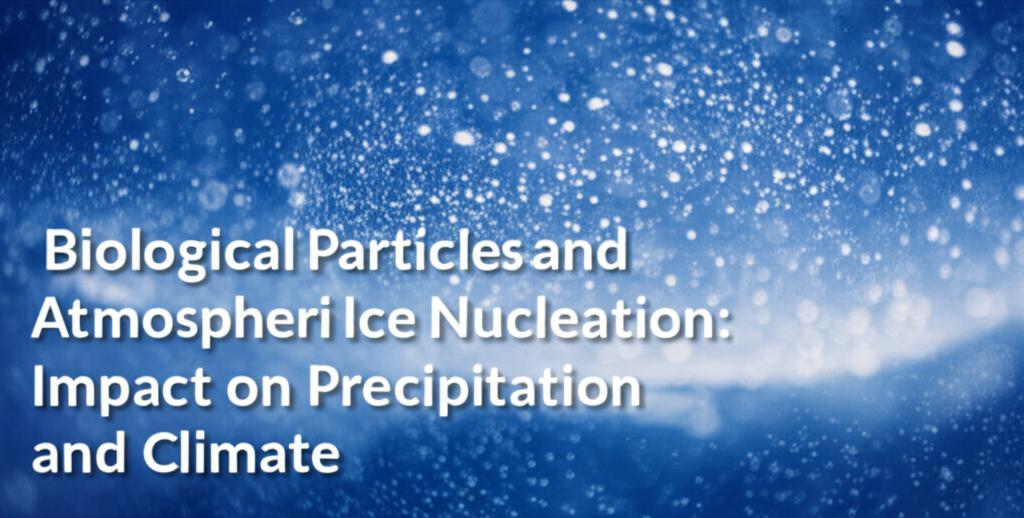Biological particles, such as pollen, bacteria, fungal spores, and plant matter, play a significant and increasingly recognized role in atmospheric ice nucleation, which in turn impacts precipitation patterns and climate. These particles, often referred to as ice-nucleating particles (INPs), can initiate ice crystal formation in clouds at much warmer temperatures (above -20°C, some even active between -13°C and 0°C) than other common atmospheric particles like mineral dust. Pure water droplets in clouds can remain liquid down to about -38°C before freezing homogeneously. However, the presence of INPs allows ice to form at these higher temperatures, a process called heterogeneous ice nucleation.
Impact on Clouds and Precipitation:The formation of ice crystals in clouds is a crucial step in the development of most precipitation worldwide. Biological INPs are particularly efficient at this process. Their ability to promote ice formation at warmer temperatures means they can significantly influence cloud properties, including their lifetime, radiative effects (how they reflect sunlight and absorb heat), and their likelihood of producing precipitation.
Recent research highlights that the concentration of these biological particles in the atmosphere isn't constant. For instance, studies in alpine regions have shown a daily cycle, with concentrations of biological INPs peaking around midday as temperatures rise and forests release these particles. This daily rhythm can influence cloud formation and potentially trigger intense rain and snow events. Rainfall itself can also lead to an increased release of biological particles from ecosystems, potentially creating a positive feedback loop where precipitation encourages the release of more biological INPs, which then promote further precipitation.
Different types of biological particles can have varying impacts. For example, some bacteria-sized particles are strongly linked to ice formation when local forest sources are dominant, while larger fungal spores and pollen fragments may become more important during dust events.
Significance for Climate and Climate Models:The influence of biological INPs on clouds and precipitation has significant implications for our understanding of Earth's climate system. Clouds play a dual role, capable of both cooling the planet by reflecting sunlight and warming it by trapping heat. The exact nature of this effect depends on cloud properties, which are influenced by the particles around which they form.
Current meteorological and climate models often do not fully account for the effects of biological particles or their cyclical nature. This omission means that these models might be missing important factors that modulate clouds and drive precipitation, potentially affecting the accuracy of current and future climate forecasts. As the climate warms, the presence of biological particles in the atmosphere is expected to increase due to factors like changing vegetation cover and less sea ice, further emphasizing the need to incorporate them into models.
Regional Importance, Including the Arctic:The impact of biological INPs is not limited to specific regions. Research in the Arctic, a region warming significantly faster than the rest of the planet, has shown a strong connection between biological particles and ice crystal formation at relatively high temperatures (as high as -15°C). In the Arctic summer, a very high percentage (over 90%) of particles that initiate ice crystal formation at these warmer temperatures are of biological origin. Even in winter, this proportion remains substantial (50% to 85%). As the Arctic continues to warm, leading to more bare land and vegetation, the levels of biological particles are likely to increase, further influencing Arctic clouds and climate.
Similarly, studies over oceans like the North Pacific, Bering Sea, and Arctic Ocean suggest that marine biota contribute to atmospheric bioaerosols, which can act as both cloud condensation nuclei (CCN) and INPs, especially during periods of high biological activity.
Challenges and Future Research:Despite growing understanding, there are still uncertainties and gaps in our knowledge. Accurately simulating the concentrations and variability of biological INPs in large-scale climate models remains a challenge. This requires better understanding of their sources, how they are released into the atmosphere (aerosolization), their transport, and their specific ice-nucleating efficiencies.
Future research will focus on developing novel detection techniques and improving simulation models. There's also a need for more comprehensive investigations into the characteristics and influencing factors of atmospheric biological INPs across diverse ecosystems. For example, studying the relationship between the hygroscopicity (ability to absorb moisture) and ice-nucleating activity of bioaerosols is crucial to understanding their real-world effects on cloud formation.
In summary, biological particles are emerging as critical players in atmospheric processes. Their unique ability to initiate ice formation at warmer temperatures significantly influences cloud development, precipitation, and consequently, regional and global climate. Continued research and integration of this knowledge into climate models are essential for accurately predicting future weather patterns and climate change.

